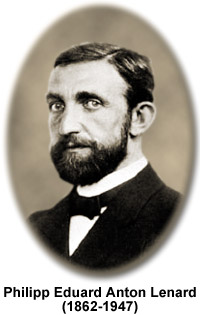Philipp Eduard Anton Lenard
(1862-1947)

Philipp Lenard is somewhat of controversial figure in the history of science. He undoubtedly made significant contributions to the field of physics, but suffered in reputation in his later life due to his alignment with the Nazi party and his unfounded condemnation of other scientists, especially Albert Einstein and other individuals with Jewish backgrounds. Ironically, it was Einsteinís theoretical work that helped make sense of some of Lenardís most important experimental work on the photoelectric effect and which greatly influenced the Nobel Foundationís decision to award the 1905 Nobel Prize for Physics to Lenard.
Lenard was born in Pressburg, Hungary (now part of Slovakia) on June 7, 1862 and studied physics in a number of different cities, including Budapest, Vienna, Berlin, and Heidelberg, eventually receiving his doctorate in 1886. By 1888, Lenard began experimenting with cathode rays, but it was not until 1892, when he became an assistant to Heinrich Hertz at the University of Bonn, that his more famous investigations were undertaken. In his first year with Hertz, he developed a cathode tube containing what came to be known as a Lenard window, through which a beam of cathode rays could be obtained outside of the tube. In constructing the window, Lenard applied Hertzís discovery that cathode rays can pass through thin pieces of metal. Lenardís cathode tube design enabled the physicist to investigate cathode rays in a way not previously possible and he, therefore, made important discoveries concerning their characterization. For instance, utilizing a phosphorescent screen in conjunction with his cathode tube, he demonstrated that cathode rays decrease in number as the distance between the tube and screen increases and also that the ability of materials to absorb the rays depends on their density rather than their chemical makeup. These and other early findings were published by Lenard in 1894.
Several years later, Lenard again expanded on the work of Hertz by carrying out investigations on the photoelectric effect, a phenomenon discovered by Hertz around 1887. Utilizing a photocell coupled to a circuit with a variable power supply, voltmeter, and microammeter, Lenard showed that the intensity of light used to eject photoelectrons form a metal surface had no effect on the velocity or kinetic energy of those photoelectrons. Instead, he found that the kinetic energy of the photoelectrons varies with the wavelength or frequency of incident light, increasing as the wavelength decreased or frequency increased. Such findings were not in keeping with the predominant view in the late nineteenth century that light was a transverse wave, which, if true, would presumably mean that a beam of light with greater intensity would eject photoelectrons with more energy than less intense light, regardless of the frequency. The fact that Lenardís experiments suggested that this was not the case created a fundamental quandary in the field of physics. Eventually, Einstein would demystify the phenomenon with his publication of a paper in 1905, which suggested that the experimental observations of Lenard and other scientists studying the photoelectric effect could be explained if individual quanta of light, rather than waves of light, were penetrating the metal samples and knocking photoelectrons loose from atoms contained therein.
Although Einsteinís quantitative theory of light was critical in demonstrating the true import of Lenardís experiments, Lenard apparently begrudged Einsteinís discovery. Thus, his public condemnation of ďJewish scienceĒ was likely not only attributable to his extreme nationalism and membership in Hitler's National Socialist Party, but also to a personal grievance against the scientist whose fame came to greatly exceed his own. During Hitlerís regime, Lenard was appointed Chief of German (or Aryan) Physics. Before that time, the physicist taught at a number of different institutions, including the universities of Breslau, Aix-la-Chapelle, Heidelberg, and Kiel. Lenard also composed many books on cathode rays and other aspects of physics, and he received many awards in addition to the Nobel Prize before his death on May 20, 1947.
